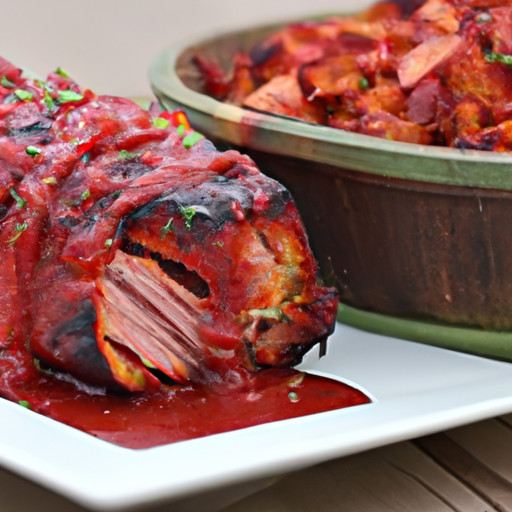Experience the mouthwatering journey through the evolution of American BBQ, as we trace its roots from humble pits to the succulent plates of today. Join us on Tastepan.com as we explore the fascinating world of food culture and traditions, delving into the histories, flavors, and regional variations that have shaped American BBQ into the beloved culinary art it is today. From smoky, slow-cooked meats to delectable tangy sauces, prepare to immerse yourself in the rich heritage and tantalizing flavors that make American BBQ a true feast for the senses.
Origins of American BBQ
American BBQ has a rich history that can be traced back to its origins and the various influences that have shaped its development over time. From the introduction of BBQ to America to the rise of BBQ joints, the development of regional BBQ styles, the science behind BBQ, and its influence on popular culture, this article will take you on a comprehensive journey through the world of American BBQ.

Introduction of BBQ to America
The story of American BBQ begins with its introduction to the country by European explorers and settlers. Spanish conquistadors brought the concept of barbacoa, a slow-cooking method using an open flame, to the Americas in the 16th century. This method eventually made its way to the southern colonies of America, where it evolved into what we now know as BBQ.
Influence of African and Native American cooking techniques
As BBQ became a popular cooking method in the southern colonies, it began to incorporate cooking techniques and flavors from African and Native American cultures. African slaves, who were skilled in cooking and brought with them their knowledge of smoking meats, played a significant role in shaping the development of American BBQ. Native American tribes also contributed to the evolution of BBQ by introducing new ingredients and cooking methods.
Development of regional BBQ styles
As BBQ continued to gain popularity in America, different regions began to develop their own distinct styles and flavors. These regional styles emerged as a result of local ingredients, cooking techniques, and cultural influences. Some of the most notable regional BBQ styles in America include Texas-style BBQ, Kansas City-style BBQ, Carolina-style BBQ, and Memphis-style BBQ. Each style has its own unique characteristics, such as the use of specific meats, sauces, and cooking methods.
The Rise of BBQ Joints
Early BBQ joints in the 19th century
In the 19th century, BBQ joints began to emerge as popular gathering places where people could enjoy affordable and flavorful smoked meats. These early BBQ joints were often small roadside stands or shacks, where pitmasters cooked their meats for hours on traditional BBQ pits. These establishments quickly became social hubs, attracting people from all walks of life to indulge in the delicious flavors of BBQ.
Popularity of BBQ during the Great Depression
During the Great Depression in the 1930s, BBQ gained even more popularity as an affordable and hearty meal option for families struggling to make ends meet. BBQ joints became places of solace and comfort, where people could forget their hardships for a brief moment and enjoy a flavorful meal. The simplicity and affordability of BBQ made it a beloved food of the people during this challenging time.
The BBQ renaissance in the 20th century
In the later part of the 20th century, BBQ experienced a renaissance as it started to gain recognition beyond its regional roots. BBQ enthusiasts and pitmasters began to experiment with flavors, techniques, and even equipment, leading to the birth of new BBQ styles and the fusion of different culinary traditions. BBQ competitions and festivals also played a crucial role in popularizing BBQ and bringing it into the mainstream.
Regional BBQ Styles
Texas-style BBQ
Texas-style BBQ is known for its emphasis on beef, particularly brisket. The meat is cooked low and slow over indirect heat, usually using mesquite or oak wood for a rich and smoky flavor. Texas-style BBQ is often served with simple rubs or just salt and pepper, allowing the natural flavors of the meat to shine. Popular Texas BBQ joints, such as Franklin Barbecue in Austin, have gained national recognition for their mouthwatering brisket.
Kansas City-style BBQ
Kansas City-style BBQ is all about variety. This style of BBQ incorporates different meats, including beef, pork, and chicken, and is characterized by its thick and tangy tomato-based sauces. The meats are slow-cooked over a variety of woods, such as hickory and oak, to infuse them with a smoky flavor. Kansas City-style BBQ is often served with a side of coleslaw and baked beans, creating a balanced and satisfying meal.
Carolina-style BBQ
Carolina-style BBQ is divided into two distinct styles: Eastern Carolina and Western Carolina. In Eastern Carolina, whole hogs are slowly cooked over a pit, and the meat is shredded and mixed with a vinegar-based sauce. Western Carolina, on the other hand, focuses on pork shoulders and adds a tomato-based sauce to the mix. Both styles of Carolina-style BBQ showcase the region’s love for pork and the unique flavors of their respective sauces.

Memphis-style BBQ
Memphis-style BBQ is known for its dry rubs and slow-cooked ribs. The dry rubs, made with a combination of herbs and spices, create a flavorful crust on the meat. Memphis-style BBQ is also famous for its use of sweet and tangy tomato-based sauces, which are brushed on the meat towards the end of the cooking process. The result is tender and juicy ribs with a perfect balance of flavors.
The Science behind BBQ
Using smoke and indirect heat for slow cooking
One of the fundamental aspects of BBQ is the use of smoke and indirect heat for slow cooking. This method allows the meat to cook slowly, breaking down tough muscle fibers and developing complex flavors. The smoke from the wood adds another layer of flavor, enhancing the taste of the meat. Different types of wood, such as hickory, mesquite, and fruitwoods, offer unique flavors that can complement or contrast with the meat.
The Maillard reaction in BBQ
The Maillard reaction is a chemical reaction that occurs when proteins and sugars in the meat are exposed to high heat. This reaction creates the browned crust on the surface of the meat, which is responsible for the rich and complex flavors in BBQ. The longer the meat is cooked, the more pronounced the Maillard reaction becomes, resulting in a deeper flavor profile.
Importance of wood selection in BBQ
The choice of wood in BBQ is crucial, as it can greatly impact the flavor of the meat. Different types of wood have distinct flavors, ranging from mild and sweet to strong and pungent. For example, hickory wood creates a strong and smoky flavor, while fruitwoods, such as apple or cherry, add a subtle and sweet undertone. Pitmasters carefully select the right wood to enhance the natural flavors of the meat and create a harmonious barbecue experience.
BBQ Festivals and Competitions
The origins of BBQ festivals
BBQ festivals have a long history in America, dating back to the 18th century. These festivals were originally community gatherings where people would come together to enjoy smoked meats and celebrate local traditions. Over time, BBQ festivals have grown in popularity and size, attracting visitors from all over the country who come to indulge in the diverse flavors of BBQ.
Notable BBQ competitions in America
BBQ competitions have become a staple in American BBQ culture, showcasing the skills of pitmasters and the variety of BBQ styles across the country. One of the most prestigious competitions is the American Royal World Series of Barbecue, held annually in Kansas City. This event brings together BBQ teams from all over the world to compete in various categories, including ribs, chicken, and brisket.
Impact of BBQ competitions on the evolution of BBQ
BBQ competitions have not only elevated the status of BBQ, but they have also contributed to its evolution. Pitmasters use these competitions as platforms to showcase their innovative techniques, flavors, and presentations, resulting in the fusion and adaptation of different BBQ styles. The high level of competition pushes pitmasters to constantly innovate and experiment with new flavors, leading to the growth and diversification of American BBQ.
BBQ Tools and Techniques
Traditional BBQ pits and smokers
Traditional BBQ pits and smokers have played a significant role in the development of American BBQ. These tools, often made of metal or brick, are designed to create the ideal cooking environment for slow and low-temperature cooking. Pitmasters carefully control the fire, temperature, and smoke to achieve the desired results. Pit design and airflow are important considerations to ensure even cooking and consistent smoke distribution.
Modern BBQ equipment
With advancements in technology, modern BBQ equipment has evolved to provide convenience and efficiency without compromising flavor. Electric smokers, pellet grills, and gas grills have become popular alternatives to traditional pits. These modern tools allow for precise temperature control, automated cooking processes, and even the integration of smartphone apps for monitoring and adjusting the cooking process.

Marinades, rubs, and sauces in BBQ
Marinades, rubs, and sauces are essential components in BBQ, adding layers of flavor and enhancing the taste of the meat. Marinades are often used to tenderize and infuse flavors into the meat before cooking. Rubs, made with a mix of herbs, spices, and sometimes sugar, are applied directly to the meat’s surface to create a flavorful crust. Sauces, ranging from tangy and sweet to spicy and smoky, are brushed onto the meat during the cooking process or served as a condiment.
Influence of Immigration on BBQ
Influence of German and Czech immigrants on Texas-style BBQ
Texas-style BBQ has been greatly influenced by German and Czech immigrants who settled in the region. These immigrants introduced the concept of the “meat market” and brought with them their sausage-making traditions. As a result, sausages, particularly beef sausages like the iconic “beef links,” became an integral part of Texas-style BBQ, adding a unique flavor and texture to the cuisine.
Influence of African Americans on Carolina-style BBQ
African Americans have had a significant influence on Carolina-style BBQ, especially in the Eastern Carolina region. Enslaved African Americans brought their cooking techniques and flavors to the region, which eventually shaped the style of BBQ in that area. The vinegar-based sauces, which are a hallmark of Eastern Carolina BBQ, have their roots in African cooking traditions, specifically the use of tart and tangy flavors to enhance the taste of meats.
Influence of Jewish immigrants on BBQ
Jewish immigrants have also left their mark on American BBQ, particularly in areas like New York City. Jewish barbecue traditions, similar to Eastern European cuisines, incorporated smoked and cured meats like pastrami and corned beef. These traditions found their way into American BBQ, adding a unique twist to the already diverse culinary landscape.
Health and Sustainability in BBQ
Grilling vs. smoking: Which is healthier?
When it comes to health, the cooking method used in BBQ can make a difference. Grilling, which involves cooking meat over direct heat, can lead to the formation of harmful compounds, such as polycyclic aromatic hydrocarbons (PAHs) and heterocyclic amines (HCAs), which are associated with an increased risk of certain cancers. On the other hand, smoking, which is the primary cooking method in BBQ, is considered healthier as it involves cooking the meat indirectly over low heat, resulting in reduced formation of these harmful compounds.
Sustainable wood sources for BBQ
As the demand for BBQ continues to grow, it’s important to consider the sustainability of the wood used for smoking. Certain wood sources, such as mesquite and oak, are more sustainable options as they are readily available and can be harvested responsibly. Additionally, using local or regional wood sources can help reduce the carbon footprint associated with transporting wood over long distances.
Alternative BBQ ingredients and techniques
To address health and sustainability concerns, BBQ enthusiasts have begun exploring alternative ingredients and techniques. For example, using leaner cuts of meat or incorporating more vegetables in BBQ dishes can make them healthier. Additionally, alternative cooking methods, such as sous vide cooking followed by a short period on the grill or smoker for flavor, can provide a balance between convenience, health, and traditional BBQ flavors.
BBQ in Popular Culture
BBQ references in movies and TV shows
American BBQ has made its way into popular culture, and references to BBQ can be found in movies, TV shows, and even commercials. BBQ scenes often depict people coming together to enjoy a meal, highlighting the social aspect of BBQ. Whether it’s a backyard cookout or a BBQ joint scene, these references in popular culture showcase the love and appreciation for BBQ as an integral part of American food culture.
Celebrities and their love for BBQ
Numerous celebrities have publicly expressed their love for BBQ, further contributing to its popularity and cultural significance. From musicians to athletes and actors, many celebrities have their favorite BBQ joints or are avid BBQ enthusiasts themselves. Some even venture into the world of BBQ by opening their own restaurants or collaborating with established pitmasters to create unique BBQ flavors.
BBQ as a symbol of American identity
BBQ has become deeply ingrained in American culture and is often seen as a symbol of American identity. The rich history, regional variations, and the communal nature of BBQ reflect the diversity and distinctness of different regions in America. BBQ brings people together, transcending social and cultural boundaries, and fostering a sense of community. This shared experience and love for BBQ contribute to its status as an iconic representation of American food culture.
BBQ Fusion: Blending Cultural Influences
Asian-inspired BBQ dishes
The blending of cultural influences has led to the emergence of BBQ fusion, where traditional BBQ techniques and flavors are combined with elements from other cuisines. Asian-inspired BBQ dishes, for example, introduce flavors and ingredients like soy sauce, ginger, and garlic into the BBQ repertoire. These fusion dishes bring together the smokiness of BBQ with the bold and vibrant flavors of Asian cuisine, resulting in unique and exciting culinary experiences.
Mexican-infused BBQ flavors
Another popular BBQ fusion is the infusion of Mexican flavors into traditional BBQ. Mexican-inspired BBQ dishes incorporate spices like cumin and chili powder, along with ingredients like lime and cilantro, to create a bold and flavorful twist on traditional American BBQ. From smoky chipotle-rubbed ribs to tangy Mexican street corn, these fusion flavors add a new dimension to BBQ and showcase the versatility of the cuisine.
BBQ fusion restaurants
BBQ fusion restaurants have sprouted up across the country, offering a wide range of innovative dishes that blend different culinary traditions. These restaurants experiment with flavors, techniques, and ingredients to create exciting and unique BBQ experiences. From Korean BBQ tacos to Jamaican jerk-spiced ribs, BBQ fusion restaurants bring together the best of multiple cuisines, creating a melting pot of flavors that celebrates the diversity of American food culture.
American BBQ has come a long way from its humble origins to becoming a beloved and iconic culinary tradition. From the introduction of BBQ to America, the influence of African and Native American cooking techniques, the development of regional BBQ styles, the science behind BBQ, the impact of BBQ festivals and competitions, the tools and techniques used in BBQ, the influence of immigration on BBQ, health and sustainability considerations, BBQ’s presence in popular culture, to the exciting world of BBQ fusion, the story of American BBQ is a testament to the power of food in bringing people together and telling the tale of a nation’s heritage. So, fire up the grill, gather your friends and family, and feast on the flavors of American BBQ – a delicious journey through history and culture.

